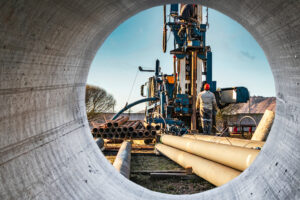[vc_row][vc_column][vc_column_text]The price of crude oil is directly related to the economy and is a good reflection of the state of world affairs. A survey of oil prices over the past forty years is best observed decade-by-decade, with a preface explaining the formation of OPEC, the organization responsible for protecting the financial interests of countries with large nature oil reserves. OPEC stands for Organization of the Petroleum Exporting Countries and was formed in 1960, but did not gain substantial influence until the beginning of the 1970’s, the decade of which this paper will commence analysis.
The prices written below account for the prices at the day of purchase, however the image of oil prices over the last four decades is brought into clearer light when adjusted for inflation. Prices were at their highest in the late 2000’s, followed by mid 2000’s and the 1980’s. Prices were at their lowest during the early 2000’s, 1970’s, and early 1990’s.
It is interesting to point out that while U.S. presidents often take the blame or credit for oil prices, it is less the price fixed by the cartels or governments that determines prices as it is the speculations of investors. Two main factors influence the prices of oil: supply & demand, and investors (whether they are hedging or speculating). Supply and demand is reflected in every level of determining oil prices. There is a demand found at the international level, within every country, from every oil company, and by every consumer. While countries can regulate supply without cooperation between suppliers, larger, more industrialized countries are capable of exploiting countries with less wealth and driving down oil prices. This was a motivating factor behind the organization of OPEC.
Unfortunately, with time and increased oil conflict, countries within OPEC became distrustful of one another, and resulted at the turn of the century in extremely low oil prices.
The term Peak Oil is derived from the economic theory that once the world’s oil extraction and production peak has been reached, oil production will fall into complete decline. This point will be reached when a balance of effective alternative energy sources has been achieved in conjunction with increasingly depleted supplies of crude oil. Peak oil is more related to maximum production than it is depletion — now experts believe peak oil will be reached before 2030.
Oil Prices in the 1970’s
While OPEC recruited member states (in addition to the initial governments of Iraq, Iran, Saudi Arabia, Kuwait, and Venezuela, fifteen more countries would join the Organization by 1971) gained influence, governments in Europe and the US declared strongly their support for Israel. This sharply increased the tensions between Western Europe/the U.S. & the Middle East. However, with the formation of OPEC, these member states had a new way to protest: by October 1973, OPEC declared an oil embargo, which resulted in a 300% increase in per barrel prices — from $3 a barrel to $12. The price hike lasted until early March 1974. Of course, OPEC was not solely to blame for this extreme rise; U.S. consumer panic reactions in combination with a significant decrease in the value of the U.S. dollar are also responsible for the spike in oil prices during this time. In an attempt to help quell the panic, the U.S. government implemented gas rationing, which had the opposite effect, driving consumers to stockpile what they could. In conjunction with other external political turmoil, this sparked a global economic recession, leading to the significantly deflated oil prices in the 1980’s. It was thought until early 2015 that peak oil was reached in the 1970’s.
Oil Prices in the 1980’s
To avoid OPEC’s high oil prices, countries began investigating alternative methods of energy and oil production. One way they did this was by investing in alternative energy research and methods, such as natural gas, solar power, nuclear power, and coal. They also sought out countries that were not members of OPEC, to purchase oil at lower prices. In retaliation, many OPEC companies set oil quotas to help level the price field. However, this did not reverse the damage to prices caused by Saudi Arabia saturating the market with cheap oil in the mid-eighties. Prices fell to less than $10 a barrel, but steadily increased into the early nineties. During this decade, the U.S. saw a dramatic increase in the number of domestic oil rigs, but domestic production costs were high, so foreign oil remained financially appealing.
Oil Prices in the 1990’s
The increase in prices during the late eighties and early nineties saw their peak at about $30 a barrel, but tension in the Middle East (primarily Iraq and Iran) caused OPEC to lose influence and power. Member states felt distrust between each other and prices fell. The age-old adage, “together we stand, divided we fall,” rang true and during the Gulf War the majority of the devaluation flourished. Prices slipped below $15 a barrel between 1995 and the millennium. Although around 1998 cooperation within the member states helped deter the sinking prices by slowing production, the damage was done. While former President Clinton takes much credit for these lowered oil prices (as did former President George W. Bush in the early 2000’s) it was more a blunder on the part of OPEC than a success by these U.S. presidents that caused oil prices to fall. At the dawn of the millennium, OPEC member states found their influence severely diminished, and in 2000 Venezuela, one of the original OPEC states, called a conference for members to regroup and reevaluate their role in controlling oil prices.
Oil Prices in the 2000’s
The devastation caused by the terrorist attack of September 11th, 2001 resulted in an increase in oil prices that not even OPEC had aimed for. In combination with the Iraq war and consumer panic, oil prices soared in the early 2000’s. The Iraq war proved to be an excellent method to gain access to more favorable oil treaties for the U.S. and Europe. Yet, during the economic recession of the mid and late 2000’s, prices rose again to nearly $100 a barrel, before experiencing a sharp retreat to near $50 a barrel before almost doubling again by 2010. This is explained by events in the complicated field of finance and the stock market. Because of the collapse caused by the implosion of real estate and mortgages, the U.S. dollar weakened and inflation rose. Prices fell and investors wanted to keep their cash. Oil prices tanked — but quickly bounced back. Because the world economy was also in recession, the U.S. dollar faired remarkably well, and led to an increase in oil prices. This was not good for the U.S. consumer, who saw the crisis manifest itself in higher unemployment rates, but it was very good for oil companies.
It is difficult to predict what oil prices will look like in the future. The details investors use to predict oil prices are many and in reality, unpredictable. The development of alternative energy sources is rapidly becoming a competitor for oil rich countries, as is the shift towards domestic oil. If opened in the U.S., the Keystone Pipeline could mean big changes in oil prices, but also devastating challenges for the environment. A look at the shifts in oil price over the last four decades explains the past, but only marginally helps predict the future. Only time will tell how the world economy will handle the population boom, increasing oil demand and decreasing oil supply, and what prices will come of these changes.[/vc_column_text][/vc_column][/vc_row]




